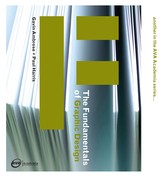
Job No:01077 Title:The fundamentals og Graphic Design
2ND
Proof Page:66
66 The Fundamentals of Graphic Design Influences and creative elements
Symbols, icons and indexes
Symbols are physically recognisable representations
of items, while icons rely on a shared understanding.
For example, ‘dog’ could also be a symbol – a pictorial
element that communicates a concept, idea or object,
such as a sign, pictogram or a graphic element, which
describes an action, or series of actions, through
visual references or clues. A red cross is a
universally understood icon, which means help or
medical treatment.
Indexes are signs that link to an object – for
example, a horseshoe or an anvil could be an index
for a horse.
Semiotics
Semiotics is the study of signs that offers an
explanation of how people extract meaning from
words, sounds and pictures. An understanding of
semiotics helps a designer to instil work with
references that enable them to communicate multiple
layers of information to a reader.
Semiotic principles
Designers use images to communicate. When images
are developed through the application of semiotic
principles, a graphic device can be made to mean
more than it would appear to be at first glance. The
type of image, its style and presentation, its quality
and how it has been reproduced can all add layers of
meaning to the overall design, drawing different
meanings from the context in which it is placed. The
bee design (opposite) for Waitrose honey is a good
example of this as three parallel lines on the bee’s
body become an ‘E’ within the context of the row of
letters they are placed in.
Sign
Signs are often graphic elements that are used to
visually represent an object, person or idea by
reducing it to simple and instantly recognisable
characteristics. For example, through the sign or
signifier ‘dog’, an image of a dog is conveyed; the
letters ‘d’, ‘o’ and ‘g’; or a recording of a bark, give the
same message. A dog can also be represented by a
graphic sign, sketch or icon. An example is the red
cross – a widely recognised sign indicating that
people can obtain medical treatment.
024-071 01077_C1.qxd 8/21/08 10:13 AM Page 66

Job No:01077 Title:The fundamentals og Graphic Design
2ND
Proof Page:67
Nostalgia and rhetoric < Semiotics > Vernacular 67
Waitrose honey packaging
Turner Duckworth’s packaging for
Waitrose honey features a simple
typographic treatment that plays with
the ‘E’ in ‘HONEY’ to create an icon in
the form of the stripy body of a bee.
The versatile design is also an index
because it suggests a slotted wooden
honey spoon.
Symbols
This horse image visually represents a
horse because it looks like a horse.
This horseshoe icon represents a
horse at its most basic level, but it
implies other meanings such as horse
racing and even luck.
This anvil is a link or index to a horse or
blacksmith, although it depicts neither.
Icons Indexes
024-071 01077_C1.qxd 8/20/08 10:11 AM Page 67

Job No:01077 Title:The fundamentals og Graphic Design
1ST
Proof Page:68
B
B
B B BB
024-071 01077.qxd 8/4/08 9:38 AM Page 68
Job No:01077 Title:The fundamentals og Graphic Design
1ST
Proof Page:68
Font choices
Fonts are not just symbols representing sounds; they also have cognitive qualities that help tell stories, which means
designers need to consider things that are conveyed in addition to what is actually said. For example, each of these six
fonts has a different personality that says more than just ‘B’ to a reader.
68 The Fundamentals of Graphic Design Influences and creative elements
Denotative
A denotative meaning is the explicit literal meaning
that we take from an image, essentially, taking what
we see at its face value. For example, ‘woman’ could
mean or indicate someone of the female gender, or
be a mother or sister.
Graphic designers need to consider both the
cognitive and denotative values that may be instilled
into a piece of work due to the way that information is
presented. Different and possible interpretations can
lead to confusion and contradiction where there is
conflict between what we see (denotative) and what
we perceive (cognition).
Cognitive
The way in which an image is presented dramatically
affects how information is interpreted. Images are
powerful communication devices because people can
extract many different values from them as they often
have cognitive meanings far beyond their denotative
elements.
Cognition refers to things that we have
perceived, learned or reasoned. A picture of a
woman denotes a female, but woman may have other
connotations such as family, beauty and love. In the
example above, the visual presentation provides
cognitive hooks that colour how we interpret the
information presented, both in terms of the vivid
red colour and the font selection.
Made in Medway (right)
Made in Medway is a book designed and produced by Steve
Rowland in collaboration with Medway Renaissance, an
organisation that champions the Medway region of the UK.
The book features works and insights into artists and designers
in the area. On a denotative level, the title type clearly conveys
what the book is about. On a cognitive level, the use of type that
has been threaded implies craft or being handmade.
024-071 01077.qxd 8/4/08 9:38 AM Page 68

Job No:01077 Title:The fundamentals og Graphic Design
2ND
Proof Page:69
Nostalgia and rhetoric < Semiotics > Vernacular 69
Saturday Night Experience (above)
Pictured here are CD covers created by Mark Design, London for the Saturday Night
Experience music compilations released by Azuli Records. The images are close-up
portraits that have a lot of light reflection appearing like perspiration on the faces of
people. They project a cognitive meaning of clubbers and dancers, while the black
background suggests or denotes the late night, after-club experience.
024-071 01077_C1.qxd 8/20/08 2:19 PM Page 69
..................Content has been hidden....................
You can't read the all page of ebook, please click here login for view all page.
